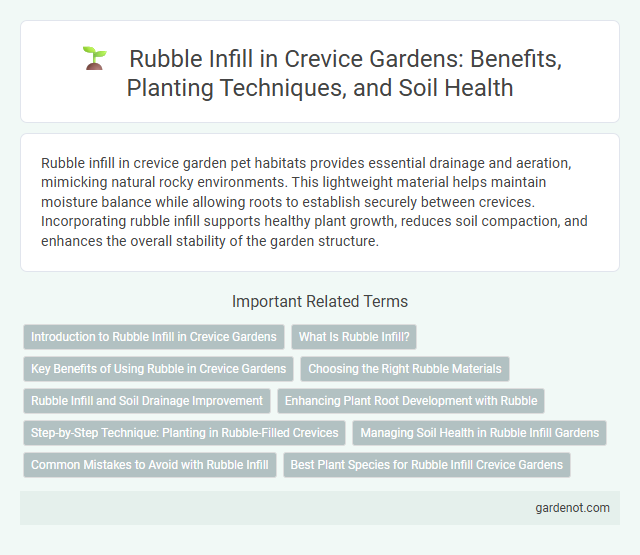Rubble infill in crevice garden pet habitats provides essential drainage and aeration, mimicking natural rocky environments. This lightweight material helps maintain moisture balance while allowing roots to establish securely between crevices. Incorporating rubble infill supports healthy plant growth, reduces soil compaction, and enhances the overall stability of the garden structure.
Introduction to Rubble Infill in Crevice Gardens
Rubble infill in crevice gardens consists of small stones, broken bricks, and organic matter placed between larger rock slabs to improve drainage and root aeration. This material mimics natural mountainous environments where crevice plants thrive by allowing excess water to escape while retaining necessary moisture. The mixed rubble creates microhabitats that support diverse alpine plant species by stabilizing soil and promoting healthy root development.
What Is Rubble Infill?
Rubble infill refers to the use of broken stones, small rocks, and debris placed between larger structural elements in a crevice garden to provide stability and improve drainage. This technique enhances the garden's ability to retain moisture while preventing waterlogging, creating an ideal environment for alpine and drought-tolerant plants. By incorporating rubble infill, crevice gardens mimic natural rocky habitats, promoting healthy root growth and improved aeration.
Key Benefits of Using Rubble in Crevice Gardens
Rubble infill in crevice gardens enhances drainage and prevents waterlogging, creating an ideal environment for alpine and drought-tolerant plants. Its coarse texture promotes root aeration and supports plant stability within narrow rock crevices. Utilizing rubble also improves soil temperature regulation and reduces maintenance by inhibiting weed growth.
Choosing the Right Rubble Materials
Selecting the right rubble materials for a crevice garden is essential to ensure proper drainage and durability. Opt for angular stones such as limestone, granite, or basalt, which create stable crevices and allow roots to anchor effectively. Avoid overly smooth or rounded stones to prevent slippage and maintain the garden's structural integrity.
Rubble Infill and Soil Drainage Improvement
Rubble infill in crevice gardens enhances soil drainage by creating air pockets and preventing waterlogging within narrow gaps between rocks. This structure facilitates rapid water movement, reducing root rot risks and promoting healthy plant growth. Effective rubble infill ensures optimal moisture balance, critical for drought-tolerant alpine and rock garden species thriving in crevice environments.
Enhancing Plant Root Development with Rubble
Rubble infill enhances plant root development by improving soil aeration and drainage within crevice gardens, creating an optimal environment for root expansion and nutrient uptake. The irregular spaces between rubble fragments increase oxygen availability, preventing soil compaction and promoting healthy root growth. This improved root environment supports robust plant establishment and longevity in challenging crevice conditions.
Step-by-Step Technique: Planting in Rubble-Filled Crevices
Planting in rubble-filled crevices requires carefully selecting drought-tolerant alpine or rock garden plants suited for minimal soil conditions. Begin by placing coarse rubble to ensure proper drainage, then fill gaps with fine gravel or grit before inserting plants into crevices filled with a mix of gritty soil and organic matter. Maintain consistent moisture while avoiding waterlogging to promote root establishment in the shallow, well-drained rubble substrate.
Managing Soil Health in Rubble Infill Gardens
Rubble infill in crevice gardens enhances drainage and aeration, critical for maintaining optimal soil health. Incorporating organic matter like compost within the rubble matrix promotes microbial activity and nutrient retention. Regular monitoring of soil moisture levels prevents compaction and supports root vitality in these unique horticultural setups.
Common Mistakes to Avoid with Rubble Infill
Common mistakes to avoid with rubble infill in crevice gardens include using irregularly sized stones that can destabilize plant roots and impede proper drainage. Overcompacting rubble can restrict airflow and moisture movement, leading to root rot and poor plant health. Ensuring appropriate layering and selecting clean, angular rubble helps maintain structural integrity and optimal growing conditions.
Best Plant Species for Rubble Infill Crevice Gardens
Sedum species, such as Sedum acre and Sedum album, are ideal for rubble infill crevice gardens due to their drought tolerance and shallow root systems that thrive in minimal soil. Saxifraga species, especially Saxifraga x urbium, adapt well to crevice environments, anchoring securely within rubble while providing vibrant blooms. Other suitable plants include Dianthus and Sempervivum, which excel in well-drained, rocky conditions characteristic of rubble infill gardens.
Rubble infill Infographic

 gardenot.com
gardenot.com